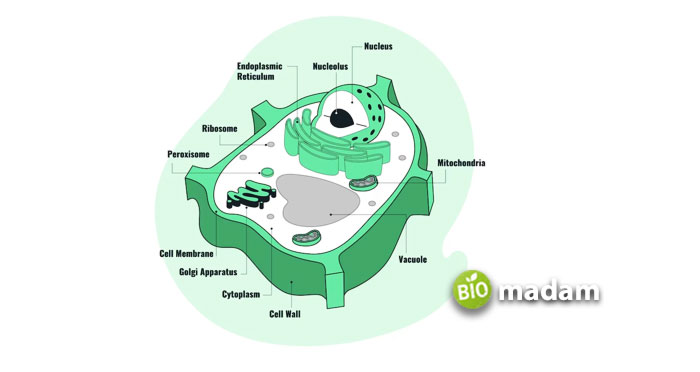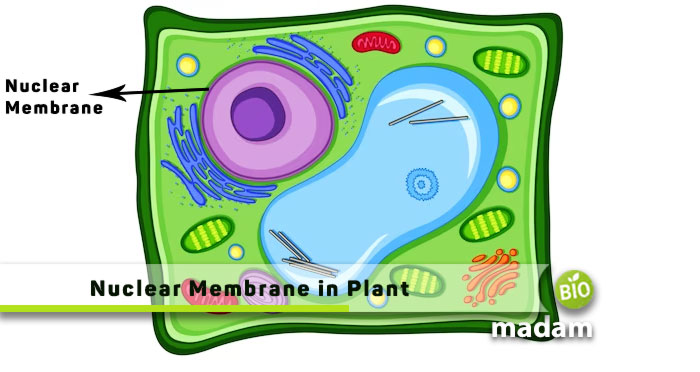Plants comprise cells which are the basic building unit of living organisms. These cells contain numerous organelles, including the plasma cell membrane, cytoplasm, endoplasmic reticulum, Golgi apparatus, etc. All plant cells also contain a nucleus that has the genetic information required for cells to divide and multiply. The nucleus is a complex organelle comprising various parts to ensure protection and proper cellular functioning. This article tells you everything about the nucleus and the function of the nuclear membrane in plant cells.
The Nucleus in Plant Cells
The nucleus, also known as the “brain of the cell,” is among the most important organelles within living cells. It contains hereditary information in the form of chromatin and chromosomes. While plant and animal cells have a nucleus, observing them under microscopes shows differences in the placement. The nucleus in an animal cell is in the middle, whereas a large vacuole in a plant cell pushes the nucleus to the side. The plant nucleus has numerous components, and the nuclear membrane is one of them besides the nucleolus and nucleoplasm.
What is the Nuclear Membrane?
The nuclear membrane is a double-layered membrane covering the contents within the nucleus.
It separates the chromatin within the nucleus from the outer environment, including the cytoplasm and other cellular components. The nuclear membrane allows the nucleus to have a secluded environment from the rest of the cell. It protects the genetic information in the nucleus and regulates the movement of molecules between cytoplasm and nucleoplasm.
Function of Nuclear Membrane in Plant Cell
Nuclear Content Protection
The main function of the nuclear membrane in plant cells is to protect the content of the nucleus from merging with the cytoplasmic organelles and molecules. It isolates the genetic material and other nuclear substances from the outer environment.
Provides Support
The nuclear membrane supports the nucleus, and the nucleus might crumble without a nuclear membrane. It gives a particular shape to the nucleus in the plant cell and protects it from the vacuole’s push impact.
Transfer of Material
The double-membrane nuclear envelope with nuclear pores monitors and regulates the movement of molecules across the nucleus. It ensures only the required material enters the nucleus from the cytoplasm.
Molecule Synthesis
Besides the transport of molecules, the nuclear membrane in plant cells also contributes to manufacturing different molecules, such as types of proteins. It allows transcription that produces mRNA to generate proteins.
Facilitates Cell Division
The nucleus contains genetic material and facilitates the division of genetic material for reproduction. However, plant cells lack centrosomes, and the nuclear membrane in plants facilitates the arrangement and division of genetic material.

Parts of Nuclear Membrane in Plants
The nuclear membrane of plant cells mainly comprises three components: the outer membrane, inner membrane, and nuclear pores.
Outer Membrane
The outer nuclear membrane is a bilayer membrane made of two lipid layers. The outer layer of the lipid membrane has ribosomes that make proteins on the surface; the ribosomes are linked to the endoplasmic reticulum.
Inner Membrane
The inner membrane of the nuclear membrane contains proteins. It allows the nuclear membrane to facilitate various functions such as DNA repair, cell division, and DNA replication.
Perinuclear Space
The space between the inner and outer nuclear membrane in the plant cell is the perinuclear space.
Nuclear Pores
The internal and external membranes of the nucleus have nuclear pores that regulate the movement of particles across the nucleus. They are made of proteins and make way for only specific molecules. Each pore contains around 30 proteins that transport materials to and from the cytoplasm.
Nuclear Membrane in Plants Vs. Animals
The most significant difference between plant and animal nuclear membranes is the absence of a nuclear lamina in the former. Plants do not have the proteins found on the animal nuclear membrane forming the nuclear lamina. Instead, they have other proteins not found in animals. Furthermore, the plant nucleus also lacks centrosomes that help animal cells organize chromosomes during division. The nuclear membrane plays a pivotal role in cell division in plant cells due to the absence of centrosomes.
What if the Plant Nucleus had no Nuclear Membrane?
The nuclear membrane helps distinguish the nuclear content from the other cytoplasmic organelles. But if there was no nuclear membrane in the plant nucleus, the nucleolus and nucleoplasm would disperse in the cytoplasm. Eventually, the cell might not have been able to organize the chromosomes for division along the plain, leading to issues. The scattering of all the nuclear content would have made multiplication and division processes more complicated.
The Bottom Line
The nucleus is an important part of the plant cell and acts as the site for cell division and multiplication. The nucleus comprises various components, including the cell membrane that covers the components of the nucleus. The nuclear membrane comprises an outer membrane, an inner membrane, and nuclear pores. They collectively facilitate the movement of molecules between the cytoplasm and nucleoplasm. Another important function of the nuclear membrane in plant cells is its support in cell division in the absence of centrosomes.
FAQs
Where is the nuclear membrane in a plant cell?
The nuclear membrane is the outermost part of the nucleus that covers the nucleoplasm and nucleolus. It protects the components of the nucleus from mixing up in the cytoplasm.
What are the two functions of the nucleus in plant cells?
The two main functions of the nucleus in the plant cell are to regulate all cellular activities and contain hereditary information. It is the main site for division and multiplication for reproduction.
Is the nuclear membrane in plant and animal cells?
All eukaryotic organisms, including animals and plants, have a nucleus covered with a porous nuclear membrane. However, the plant nucleus lacks the nuclear lamina present in animals.
What is the nucleolus in a plant cell?
The nucleolus is another component in the plant cell comprising proteins and RNA. It is the site for ribosome production in the nucleus.

Anna has completed her degree in Pharmacy from the University of Hawaii. She is serving as a research assistant in a pharmaceutical company. She had a great interest in writing blogs, traveling to different parts of the US, and trying delicious recipes in her spare time.


Hey there!!
I read this article…this is so amazing and stunning article it too helpful for my study preparation..